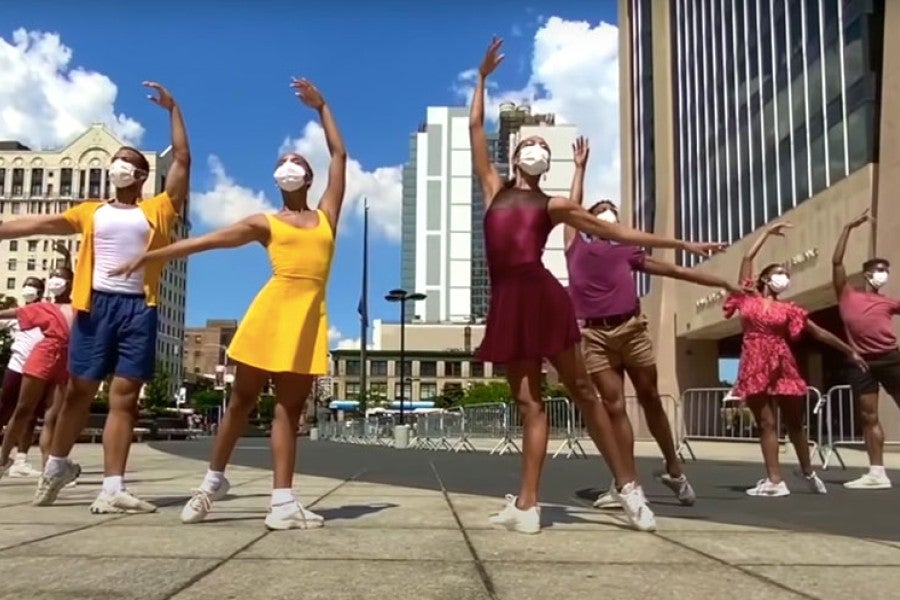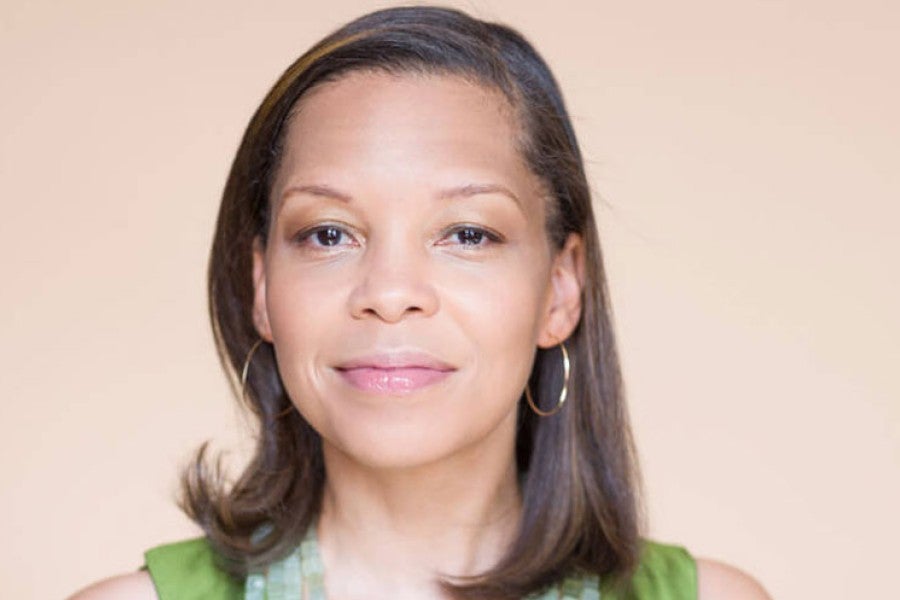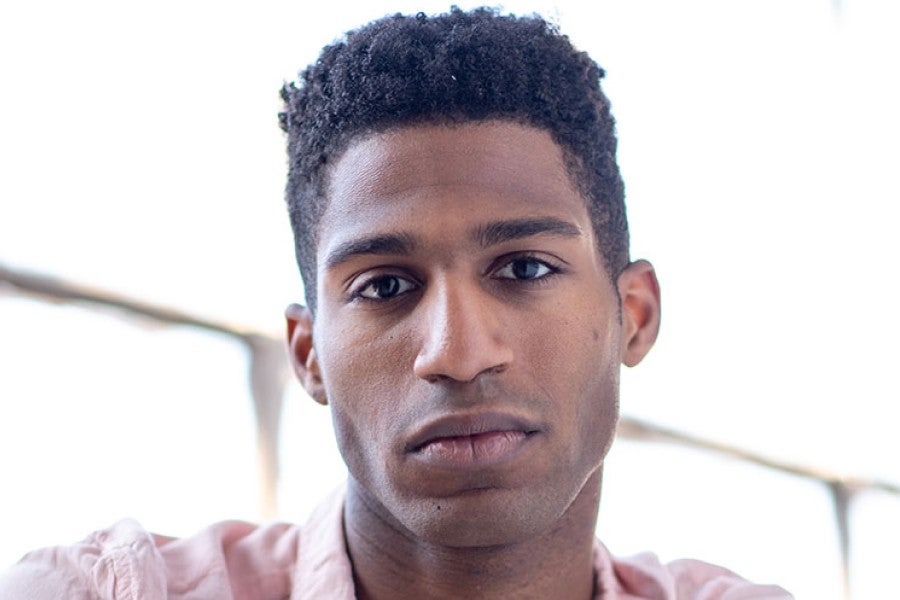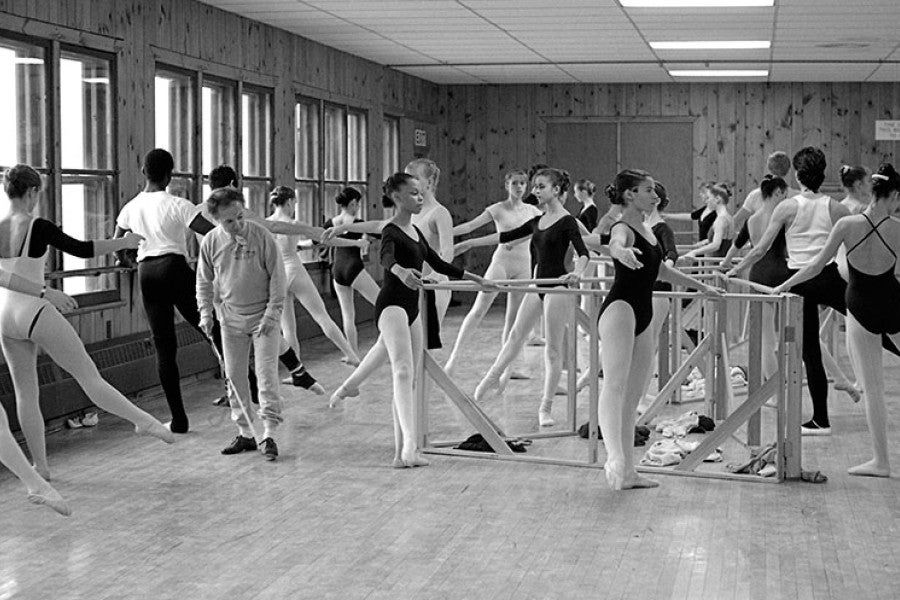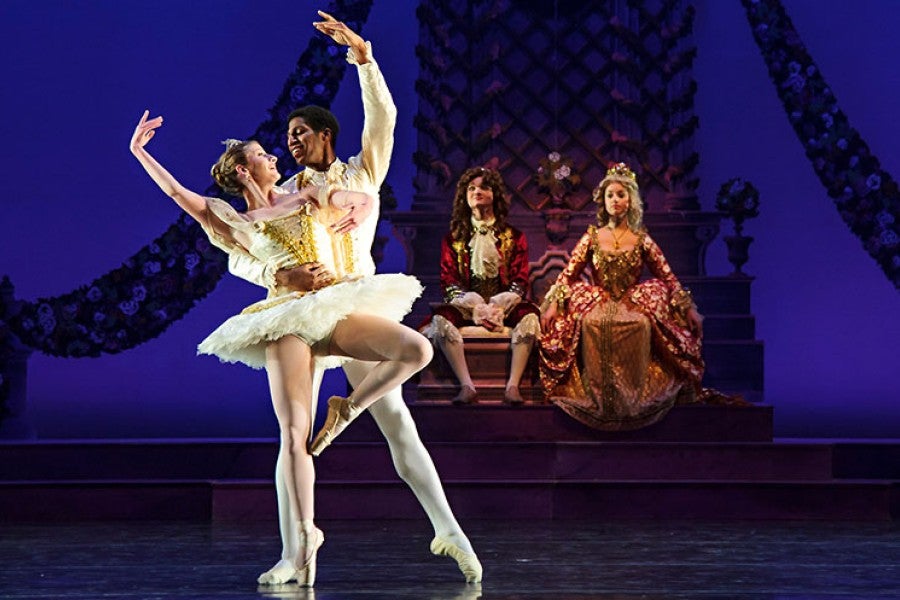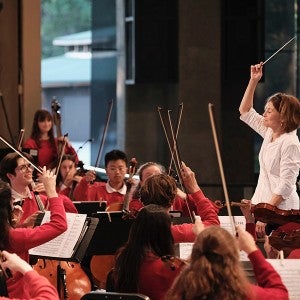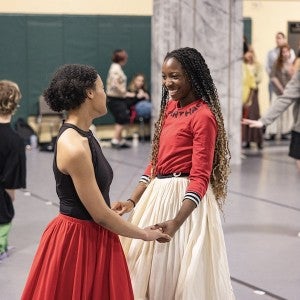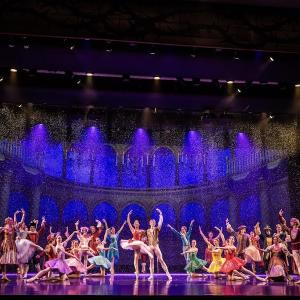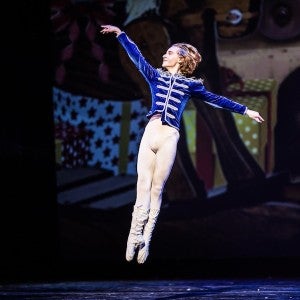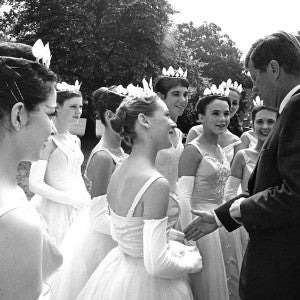In conversation with Interlochen alumni at Dance Theatre of Harlem
DTH Company member Derek Brockington and executive director Anna Glass discuss their career trajectories, the future of dance post-pandemic, and their viral video “Dancing Through Harlem.”
Derek Brockington (IAA 13-15) had just kicked off his third season with Dance Theatre of Harlem (DTH) when a video he created with another company member went viral. Produced last summer in the midst of the COVID-19 pandemic, “Dancing Through Harlem” features masked company members performing excerpts from DTH resident choreographer Robert Garland’s “New Bach” at iconic Harlem locations. The video was reposted on social media by celebrities including Janet Jackson and landed Brockington a spot on The Ellen DeGeneres Show in January.
“You don’t get to see a group of dancers of color doing classical ballet every day,” Brockington recalls. “That really stuck with people.”
A pioneer in the dance world, DTH was founded at the height of the civil rights movement by Arthur Mitchell, the first Black principal dancer at New York City Ballet. The multiethnic classical ballet company tours nationally and internationally, diversifying stages and celebrating African American culture through performances, community engagement, and arts education.
DTH was a natural next step for Anna Glass (IAA 88-90), a former dancer who previously served as managing director of 651 Arts, a nonprofit producer of music, dance, and theatre that celebrates the African diaspora. In 2014, Glass was hired by the Ford Foundation to do an assessment of DTH because it was struggling financially. Before long, the six-month gig turned into an over-six-year relationship.
“I knew Mr. Mitchell and decided to stay at DTH out of deep respect for him and the institution he created,” Glass recalls. “And we’ve turned things around and taken great strides.”
Here, Brockington and Glass chat about their career trajectories, Mitchell’s legacy, and the pandemic’s influence on the future of dance.
Derek, how did you find your way to Dance Theatre of Harlem?
Derek Brockington: After I graduated from Interlochen in 2015, I spent a year as a trainee at Grand Rapids Ballet and then two years in the second company of Cincinnati Ballet. I met Virginia Johnson, DTH’s artistic director, when she came to Cincinnati and many of the dancers at Cincinnati Ballet had dinner with her. The next year, I auditioned at IAB D, the International Association of Blacks in Dance, and she invited me to an open audition for DTH in New York.
The audition was pretty intense. It had five sections: a ballet class, variations, repertoire, partnering, and then interviews. I actually met my artistic partner on “Dancing Through Harlem,” Alexandra Hutchinson, at that audition when we partnered together. We were both chosen to join the company that year.
What was the impetus for “Dancing Through Harlem”?
D.B.: We were asked to do a virtual submission for Harlem Week, an annual festival that celebrates the Harlem community. This idea came about because we wanted to show off these beautiful spaces in Harlem that many people hadn’t seen before. I rode my bike around to pick them out, and then we had just a week to film everything.
The piece also sort of came from a place of frustration that we couldn’t dance and perform in person because of the pandemic. It was the first time the company had danced together in five months. We went over the steps and then went right into filming. Since we were in very public places, people came and watched. When you have an audience, you dance bigger, and I think that energy and joy really come through.
Anna, you earned a law degree from the University of Dayton while you were also dancing in the second company of Dayton Contemporary Dance Company. How did you start your career in arts administration?
Anna Glass: I sort of stumbled into the world of arts administration. I took on various side projects, including being on the team who choreographed the opening ceremonies of the 1994 World Cup. I then decided to move to New York City because I was really beginning to feel the pull of the arts. I moved there without a job, but Dayton Contemporary Dance Company reached out and asked me to be their booking agent.
I enjoyed that role, but found that I relied on instinct. I sought to enhance my skills by participating in a year-long fellowship program for arts administrators at the Kennedy Center, which enabled me to learn more about finance, marketing, and fundraising. That led to my being hired as managing director of 651 Arts, where I produced many shows, including a one-woman show about the legendary artist Carmen de Lavallade that toured across the country.
You both admired Dance Theatre of Harlem founder Arthur Mitchell long before you joined the organization. What aspects of his legacy are you especially passionate about?
A.G.: Mr. Mitchell recognized that this beautiful art form should reflect the diversity of this country. He wanted to not only dispel the myth that Black people couldn’t do ballet; he also wanted to broaden the understanding of ballet itself. One way he achieved this was by retelling traditional stories in contemporary settings, as he did with DTH’s Creole Giselle when he moved the location of this classic story from Germany to the bayous of Louisiana.
Mr. Mitchell also decided that the shoes and tights that our dancers wear should match their skin tones, regardless of their race. It’s always been a diverse company, with white, Asian, Black, and Latinx dancers—and everyone, regardless of their racial background or title, wears shoes that match their skin tone. This is an aesthetic, but it also signals that each dancer can bring their culture into the studio.
For DTH, ballet belongs to all people and should reflect everyone’s stories.
D.B.: I remember hearing that Arthur Mitchell said people asked him, don’t you feel special since you’re the only one? And he was like: It was terrible—I want to make sure that nobody feels that way again. And I think that’s DTH’s mission: to make sure that no one feels like they’re the only one.
Another very important part of his legacy is education. He began DTH as a school to train young dancers of color. We continue this work today. Creating opportunities for all young dancers matters as much as representation.
Anna, soon after you joined DTH, you co-led a three-year program with the International Association of Blacks in Dance and Dance/USA to support the advancement of racial equity in ballet companies across the country. How did you go about advancing this work?
A.G.: Back in 2017, Virginia Johnson, DTH’s artistic director, and I were getting tired of hearing so many conversations about diversity, equity, and inclusion in ballet that turn into panel discussions and then nothing actually happens. We were also receiving a lot of questions about DEI programs in the ballet world. So we hosted a dinner and discussion with ballet companies where we started to crack open some of these conversations. What was great was that everybody wanted to continue talking.
That dinner turned into a three-year initiative with the International Association of Blacks in Dance and Dance/USA and 20 ballet companies across the country. We took deep dives into conversations around diversity, equity, and inclusion, asking: What are our cultural biases? Where does this come from? How are we evaluating our decisions? Who are the people making the decisions?
It was an opportunity for these companies to take a moment and build consensus around some of these conversations. Change doesn’t happen overnight, but this was a beginning, and I’m very proud of our leadership.
Like most performing arts organizations, DTH’s performances and educational programs are virtual during the pandemic. Do you see any positive effects of the pandemic on the world of dance?
D.B.: The pandemic forced us to find ways to make dance exciting without live performance. As a result we are reaching broader audiences. For example, “Dancing Through Harlem” made ballet enjoyable even for people who don’t consider themselves fans. What we can do with a camera and dance now is 300 times what we could before. I'm excited to see how we’ll continue to take advantage of digital media when we have live theatre again.
A.G.: The expansion of digital media in dance has allowed more people to participate in our programs. Our normal focus is the tri-state area, but now, in our school, we’ve got students from Italy, the Bahamas, the UK—it’s just beautiful how boundaries get broken through this medium. I think that’s the most exciting piece of what’s happening.
Derek, do you have any advice for aspiring ballet dancers of color?
D.B.: Growing up, I didn’t have a lot of role models. There were dancers I looked up to, but not dancers who looked like me. There were many times where I looked in the mirror and around the room, and I was like, how am I going to be able to do this? But I just kept pushing forward, and soon enough, I saw more people in the dance world who were similar to me. And that gave me inspiration to continue.
